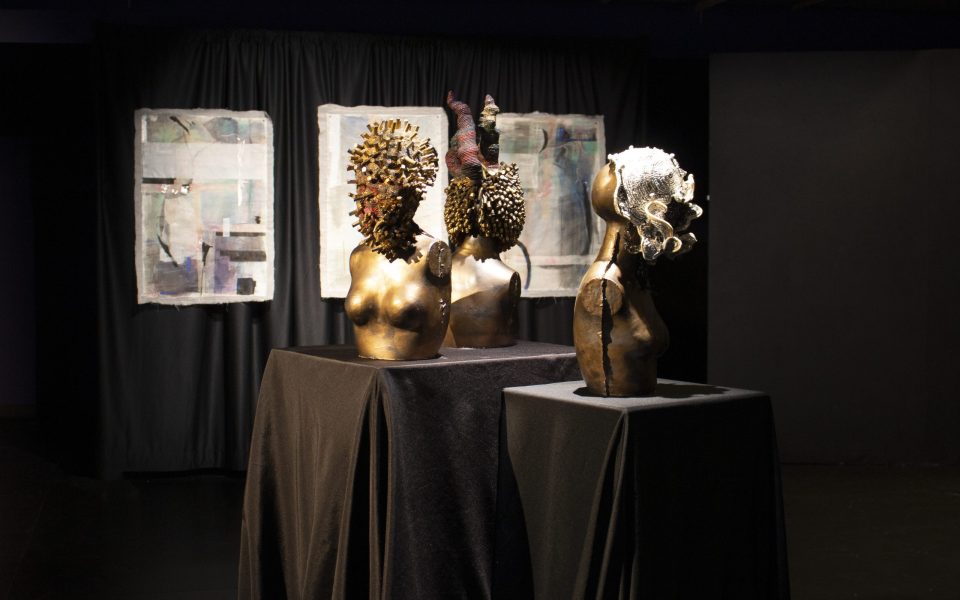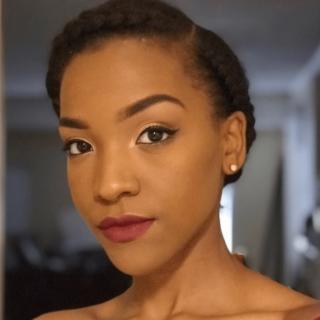Local artists need love, too.
That’s why earlier this year Derek Wiggins and Karen Wong founded Guilty By Association, an organization dedicated to raising visibility for underrepresented artists nationwide.
While ArtCities is a national project by Guilty By Association, the organization teamed up with Wake Forest University’s Wake the Arts initiative to host the first ArtCities House Party on Dec. 11 at the Milton Rhodes Center for the Arts. Five local artists — Krystal Hart, Ashley Johnson, Lakea Shepard, Mariam Aziza Stephan and Antoine Williams — were carefully selected by WFU Acquavella Curator of Collections Jennifer Finkel.
“What we’re simply trying to suggest is that there’s so much talent hidden in plain sight,” Wong says, “that the artists who live and work in our regional cities are just as good if not better than artists working in New York or LA.”
During the event, attendees learned more about the organizations, mingled with artists and purchased art.
Art buffs navigated the room, discussing their interpretations of the works they were viewing. Some visitors formed a semicircle in front of the flat-screen television. With crossed arms, raised eyebrows and faces indicating interest, they took in a documentary created by WFU’s documentary film students. Artist Lakea Shepard shook hands with fans of her traditional African art-inspired head coverings and masks.
Her father was a sculptor and mechanic; helping him in her youth led Shepard to fall in love with working with her hands. A fellow sculptor and mixed-media artist, Shepard selects each jewel and gemstone used in her pieces with intention.

“It’s important that I know where and what the materials are made of and where they come from,” she says.
In her work “428 A Gram,” she uses traditional African techniques like weaving and forcefully manipulates waxed linen, beads and even bullet casings to create a mask inspired by those worn during slavery in the United States. After learning masks were used as a means of punishment or to prevent the enslaved from eating crops as they worked on plantations, Shepard reimagined the sordid history of protecting the crops into something beautiful, using some of the men in her life as inspiration.
“I took that idea of protection and flipped it in a more positive manner,” she says.“I wanted to take a piece of every Black man that I know, and take a piece of what I’ve witnessed in their lives and try to explore it in a more positive manner.”
There in support of Shepard was her partner, Brandon Edwards, who appreciated the art of Ashley Johnson. He enjoys videography and photography, so he was drawn to portraits from Johnson’s series.
“It’s the one that stuck out to me as far as the statement behind the work,” Edwards says.
The series was inspired by a dream of Johnson’s in which a group of Black boys ran out of a group home and down a flight of rainbow stairs. They painted each other’s backs orange and proceeded to take photos. Johnson used this idea to capture performative photographs that aim to highlight all areas of the Black experience, no matter how uncomfortable.
In “…From Baptisms,” two shirtless Black men are sitting in murky waters, heads dropped and their backs facing the viewer. A white sheet extends from behind one of them. A possible interpretation of this piece is that the orange paint on their backs could symbolize blood from lashings, and the men represent the enslaved who await their next destination.

“I really want people to see themselves through it, even if it’s difficult. I really want people to ask themselves complex questions when they look at my work,” Johnson says in the documentary.
Each artist used a different medium of expression in their work, which gave variety to the exhibit. Antoine Williams favored black ink pens for his drawings of monster-like humanoids dressed in urban apparel. Miriam Aziza Stephan, inspired by the Egyptian landscapes she viewed during an extended stay in graduate school, used muted tones of gray and blue to emphasize Earth’s many shapes, forms and textures. Krystal Hart worked with natural materials like soil, fiber paper and general pigments to create collage-like pieces that emphasize the importance of sourcing materials from the earth.
According to Shepard, ArtCities has already proven beneficial to promoting underrepresented artists. Two of her pieces have sold, and as far as being among the first artists to be featured in person and online, it’s a joyous occasion.
“It feels amazing,” she says. “This opportunity has really affected my career in a very positive manner already, and we’re just beginning.”
Learn more about Guilty By Association, ArtCities and the featured artists and view the documentary at gba.family. For more information about Wake the Arts, visit wakethearts.wfu.edu.
Join the First Amendment Society, a membership that goes directly to funding TCB‘s newsroom.
We believe that reporting can save the world.
The TCB First Amendment Society recognizes the vital role of a free, unfettered press with a bundling of local experiences designed to build community, and unique engagements with our newsroom that will help you understand, and shape, local journalism’s critical role in uplifting the people in our cities.
All revenue goes directly into the newsroom as reporters’ salaries and freelance commissions.


Leave a Reply